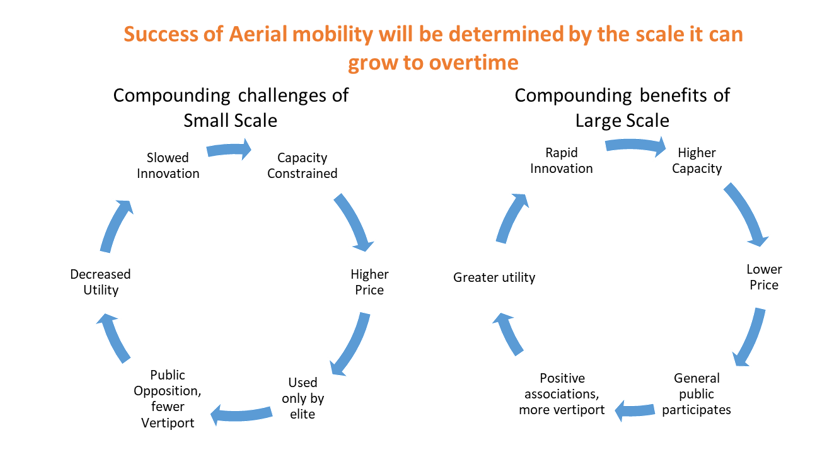Advancing Aerial Mobility: Unlocking the Future of Transportation through Innovative Aerial Solutions
- Himanshu Patni
- June 13, 2023
- AUTOMOTIVE, BLOG
- Aerial Mobility, Aerial Mobility Analysis, Aerial Mobility Forecast, Aerial Mobility Growth, Aerial Mobility Share, Aerial Mobility Size, Aerial Mobility Trends
- 0 Comments
The movement of personnel, equipment and forces through efficient aviation transportation systems using highly automated aircraft is giving rise to the AAM (advanced air mobility). AAM has been developing new types of aircraft transport to rural and urban areas in locations where traditional airplanes cannot access. These new aircraft range in size from small cargo-carrying drones to passenger-carrying air taxis. Compared to traditional means of aerial transportation, these new aircraft are small. Many of these vehicles are unmanned aerial vehicles or UAVs.
Robust control systems are required while flying in the urban areas to avoid harm to people or buildings. Urban Air Mobility, or UAM, is the name given to this aspect of AAM. UAVs carrying passengers in an urban environment cannot land anywhere, as this interferes with the existing mode of transportation. Instead, they land at Vertiports, located throughout the city. Vertiports are flight terminals for UAVs. They can be located on top of pre-existing buildings or in standalone buildings designed for UAV operations.
According to NASA market studies, by 2030 there will be 500 million flights a year for package delivery services and 750 million flights a year for air metro services. The management of this new airspace will be carried out by AAM.
As per the Deloitte and AIA analysis, AAM is expected to grow seven-fold between 2020 and 2035 from 17 USD to 115 USD respectively for combined passenger and cargo mobility.
Benefits of AAM
Agriculture– Drones equipped with sensors and digital imaging capabilities are able to provide farmers with a more detailed view of their fields, allowing them to maximize agricultural yields and farm efficiencies. It could also lower labour and equipment costs significantly
Bridge Inspection– Systematic and regular inspections can be done with the help of drones. The checking process is based on visual inspection carried out by certified inspectors, which results in high costs due to its time-consuming activity. With the help of drones, costs associated with this activity could be reduced dramatically
Lead time savings– Delivery drones can deliver packages quicker anywhere, including emergency items including medical devices, medicines, and much more in hard-to-reach places
Passenger and cost savings in Inventory– With the development of necessary infrastructure, passengers could travel by air from office to home, saving significant traveling time. Companies can save warehousing costs as they benefit from a just-in-time inventory system. Manufacturers will benefit from UAVs for cargo delivery due to the increased dependence on JIT deliveries, which will minimize warehousing expenses by reducing warehouse inventory
Challenges need to be addressed
Technology– Technological advances are needed to be scaled-up, including acoustics and noise reduction, software capabilities and ways to design safety into the system. All needs to be achieved by maintaining efficiency to overcome cost barriers
Safety and privacy– Aerial mobility should meet the safety and privacy standards and be acceptable by the public, convincing people of its minimal impact on their safety and privacy is of vital importance for the operations of these UAVs in public neighbourhood
Operations and Public relations– Acceptance of UAVs from the public will be difficult for flight operations over their homes unless noise and obtrusiveness, and effects on community life, are minimized. A public relations campaign is necessary to overcome any misunderstandings and public messaging is required for the benefits of this technology
Conclusion
AAM envisions a future with increased mobility through air for the transportation of humans and cargo, providing benefits of saved time, reduced costs, and solutions to the current logistics challenges. Its success is hugely dependent on the increased scalability of the project.
But its implementation is hindered at the moment by technological and lack of governing regulations. It is necessary to convince people about the benefits, safety, and unobtrusiveness of UAVs for them to be accepted.
Author: Abhishek Saini


